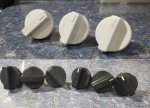Bruce
TVWBB 2-Star Olympian
Ok, bottom line. this is what I came up with.
The knobs on top are before. You will see I could not completely clean them and one was either weathered or was designed to have a kind of matte texture. They are all three random knobs from my stash and likely all from different grills. The knobs below on the left are the same knobs after dying them. The knobs below on the right are a set of factory black knobs that I also had in my stash and I put them in for comparison.
My thoughts: Keep in mind I am technically color blind, but the dyed knobs look very black to me, although not quite as shiny or glossy looking. Especially the one knob that had a kind of matte texture to it. I like the fact that they are black (much cooler than the cream color IMO). I like that the black completely covers and discrepancies and stains on the knobs that I couldn't otherwise get off. I also like the black because it won't show grease and grime like the lighter colors would. I can live with the fact that they are not as shiny as I had hoped. I am thinking it is more a symptom of the plastic not being smooth and shiny to start with rather than the dye causing it. I think it could also be from the acetone which is a solvent that will eat into plastics in too strong a dose and that could be causing a more matte look. Also, the fact that it is not truly black but "Graphite" color could be the cause. Probably the best thing is that it actually dyes the plastic and will not wear or chip off like paint.
That being said, I like it a lot and will probably do a lot more knobs this way. I am also going to try some of the gray handles to see how they come out. I am thinking they will be similar with a somewhat matte appearance as well. But, they should be very evenly and durably black after dying them as well.
I know some have used the regular Rit dye, which comes in regular Black, to color plastic parts, but according to what I understand, you should always use the Rit Dymore for plastics and other synthetics.
And this brings me to this question: What about RED or any other color for that matter. A redhead with red knobs. A blue head with blue knobs, etc...... Or a bluehead with red knobs??? What about Durawood slats and handles, or even the Silver B handles?
I did film this process tonight, but due to some unforeseen circumstances, I will reserve the right to not post up the video and embarrass myself. But, I do for sure intend to do more of this in the near future and am looking forward to posting up a HOW TO. I will be interested to if some of you run with this and come up with some great mods.

The knobs on top are before. You will see I could not completely clean them and one was either weathered or was designed to have a kind of matte texture. They are all three random knobs from my stash and likely all from different grills. The knobs below on the left are the same knobs after dying them. The knobs below on the right are a set of factory black knobs that I also had in my stash and I put them in for comparison.
My thoughts: Keep in mind I am technically color blind, but the dyed knobs look very black to me, although not quite as shiny or glossy looking. Especially the one knob that had a kind of matte texture to it. I like the fact that they are black (much cooler than the cream color IMO). I like that the black completely covers and discrepancies and stains on the knobs that I couldn't otherwise get off. I also like the black because it won't show grease and grime like the lighter colors would. I can live with the fact that they are not as shiny as I had hoped. I am thinking it is more a symptom of the plastic not being smooth and shiny to start with rather than the dye causing it. I think it could also be from the acetone which is a solvent that will eat into plastics in too strong a dose and that could be causing a more matte look. Also, the fact that it is not truly black but "Graphite" color could be the cause. Probably the best thing is that it actually dyes the plastic and will not wear or chip off like paint.
That being said, I like it a lot and will probably do a lot more knobs this way. I am also going to try some of the gray handles to see how they come out. I am thinking they will be similar with a somewhat matte appearance as well. But, they should be very evenly and durably black after dying them as well.
I know some have used the regular Rit dye, which comes in regular Black, to color plastic parts, but according to what I understand, you should always use the Rit Dymore for plastics and other synthetics.
And this brings me to this question: What about RED or any other color for that matter. A redhead with red knobs. A blue head with blue knobs, etc...... Or a bluehead with red knobs??? What about Durawood slats and handles, or even the Silver B handles?
I did film this process tonight, but due to some unforeseen circumstances, I will reserve the right to not post up the video and embarrass myself. But, I do for sure intend to do more of this in the near future and am looking forward to posting up a HOW TO. I will be interested to if some of you run with this and come up with some great mods.


